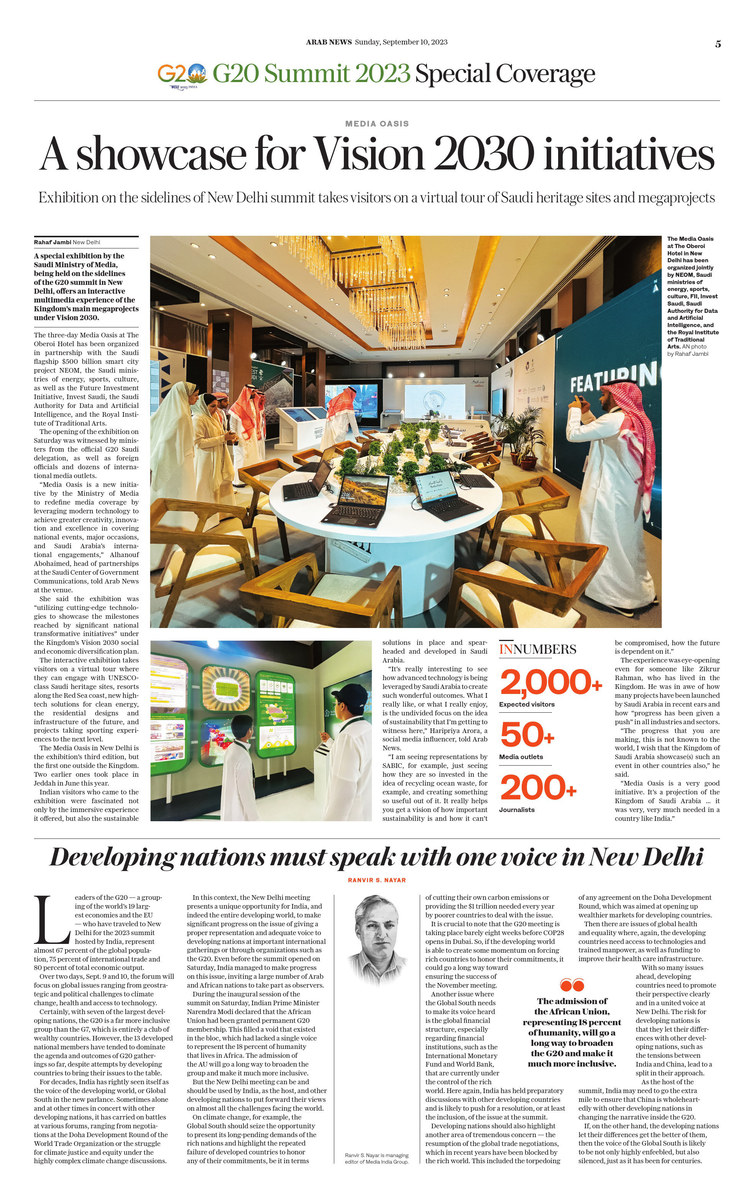NEW DELHI: A special exhibition by the Saudi Ministry of Media, being held on the sidelines of the G20 summit in New Delhi, offers an interactive multimedia experience of the Kingdom’s main mega-projects under Vision 2030.
The three-day Media Oasis at The Oberoi Hotel has been organized in partnership with the Saudi flagship $500 billion smart city project NEOM, the Saudi ministries of energy, sports, culture, as well as the Future Investment Initiative, Invest Saudi, the Saudi Authority for Data and Artificial Intelligence, and the Royal Institute of Traditional Arts.

The opening of the exhibition on Saturday was witnessed by ministers from the official G20 Saudi delegation, as well as foreign officials and dozens of international media outlets.
“Media Oasis is a new initiative by the Ministry of Media to redefine media coverage by leveraging modern technology to achieve greater creativity, innovation and excellence in covering national events, major occasions, and Saudi Arabia’s international engagements,” Alhanouf Abohaimed, head of partnerships at the Saudi Center of Government Communications, told Arab News at the venue.

She said the exhibition was “utilizing cutting-edge technologies to showcase the milestones reached by significant national transformative initiatives” under the Kingdom’s Vision 2030 social and economic diversification plan.
The interactive exhibition takes visitors on a virtual tour where they can engage with UNESCO-class Saudi heritage sites, resorts along the Red Sea coast, new high-tech solutions for clean energy, the residential designs and infrastructure of the future, and projects taking sporting experiences to the next level.
The Media Oasis in New Delhi is the exhibition’s third edition, but the first one outside the Kingdom. Two earlier ones took place in Jeddah in June this year.

Indian visitors who came to the exhibition were fascinated not only by the immersive experience it offered, but also the sustainable solutions in place and spearheaded and developed in Saudi Arabia.
“It’s really interesting to see how advanced technology is being leveraged by Saudi Arabia to create such wonderful outcomes. What I really like, or what I really enjoy, is the undivided focus on the idea of sustainability that I’m getting to witness here,” Haripriya Arora, a social media influencer, told Arab News.
“I am seeing representations by SABIC, for example, just seeing how they are so invested in the idea of recycling ocean waste, for example, and creating something so useful out of it. It really helps you get a vision of how important sustainability is and how it can’t be compromised, how the future is dependent on it.”
The experience was eye-opening even for someone like Zikrur Rahman, who has lived in the Kingdom. He was in awe of how many projects have been launched by Saudi Arabia in recent ears and how “progress has been given a push” in all industries and sectors.
“The progress that you are making, this is not known to the world, I wish that the Kingdom of Saudi Arabia showcase(s) such an event in other countries also,” he said.
“Media Oasis is a very good initiative. It’s a projection of the Kingdom of Saudi Arabia ... it was very, very much needed in a country like India.”





























